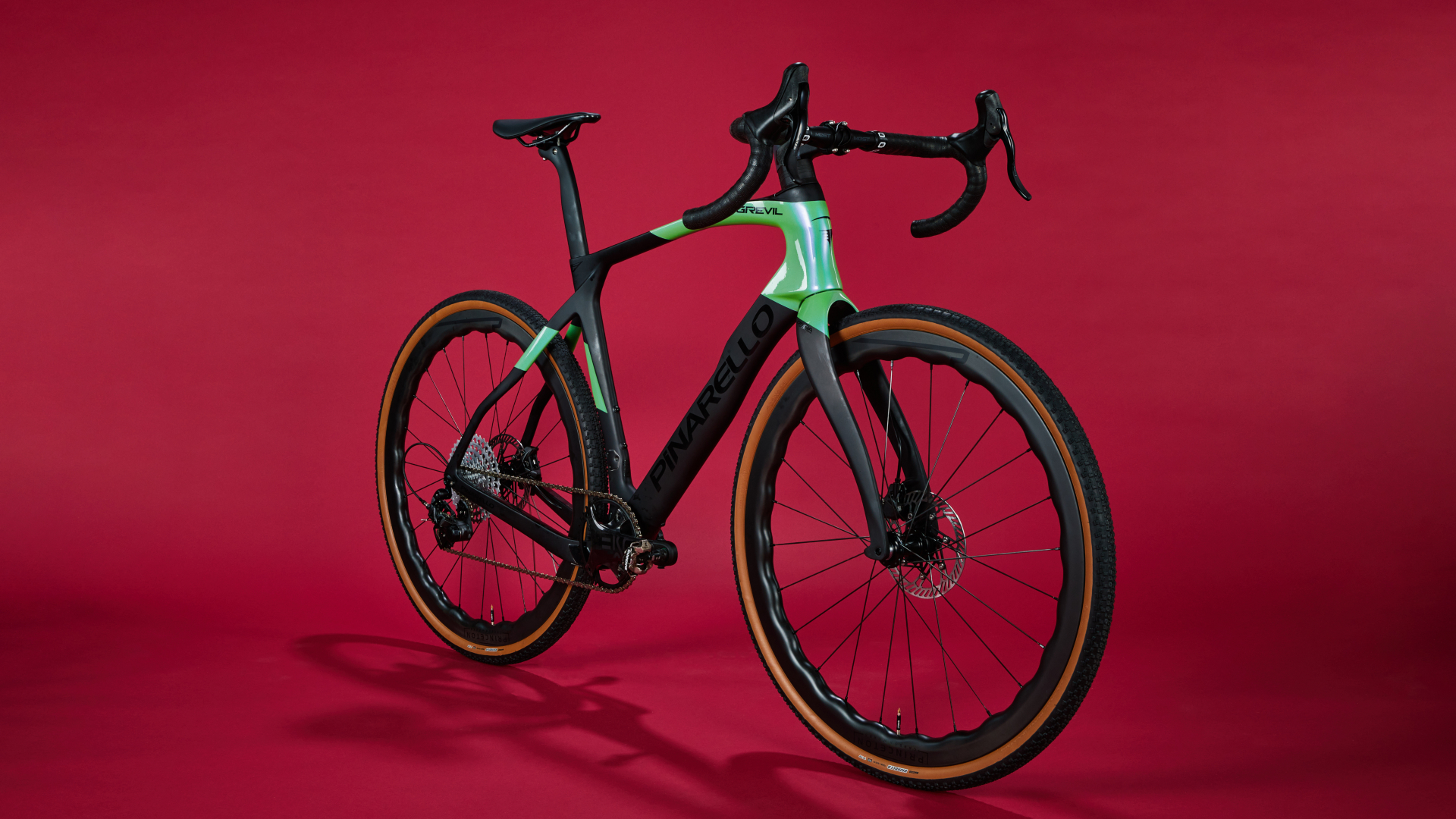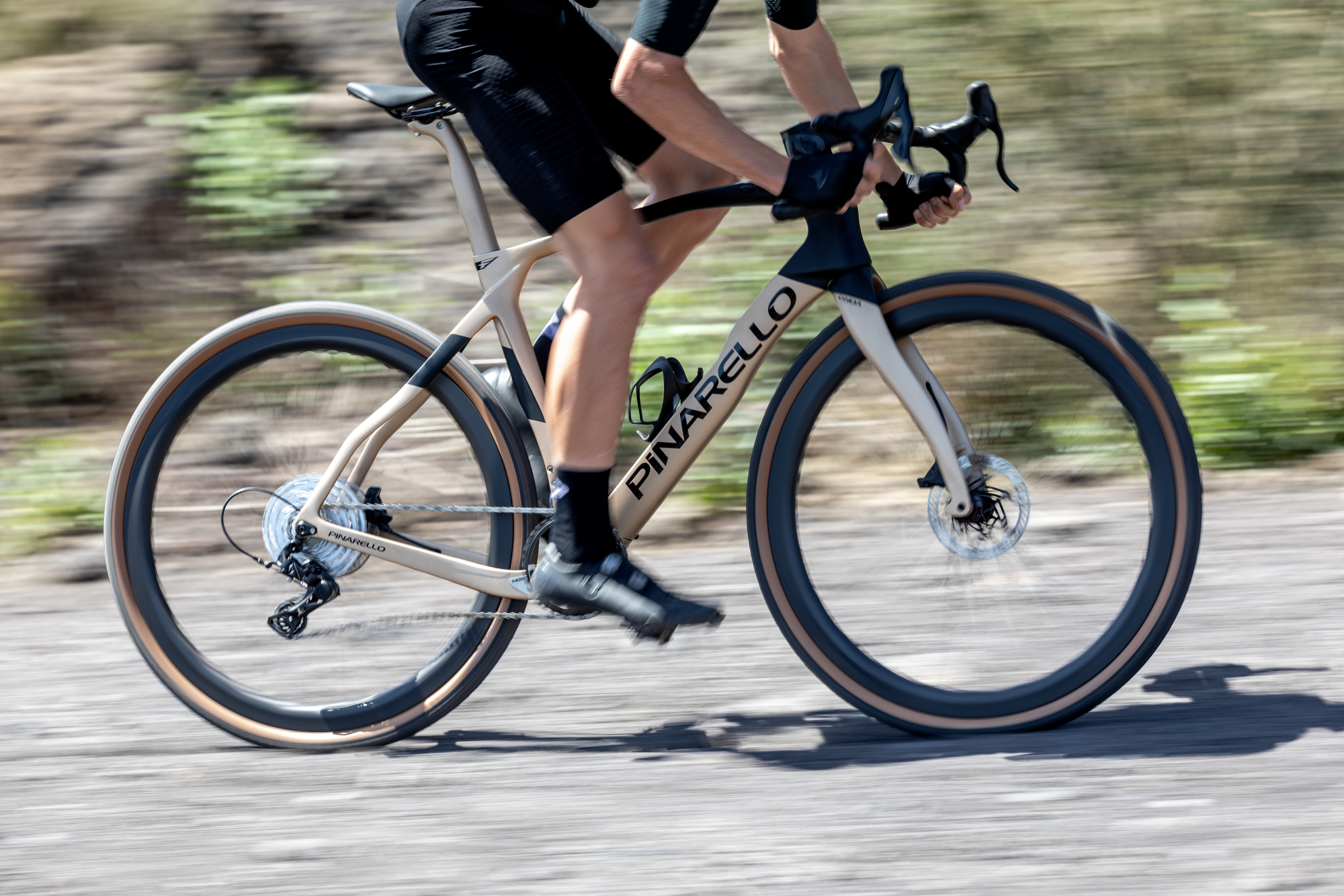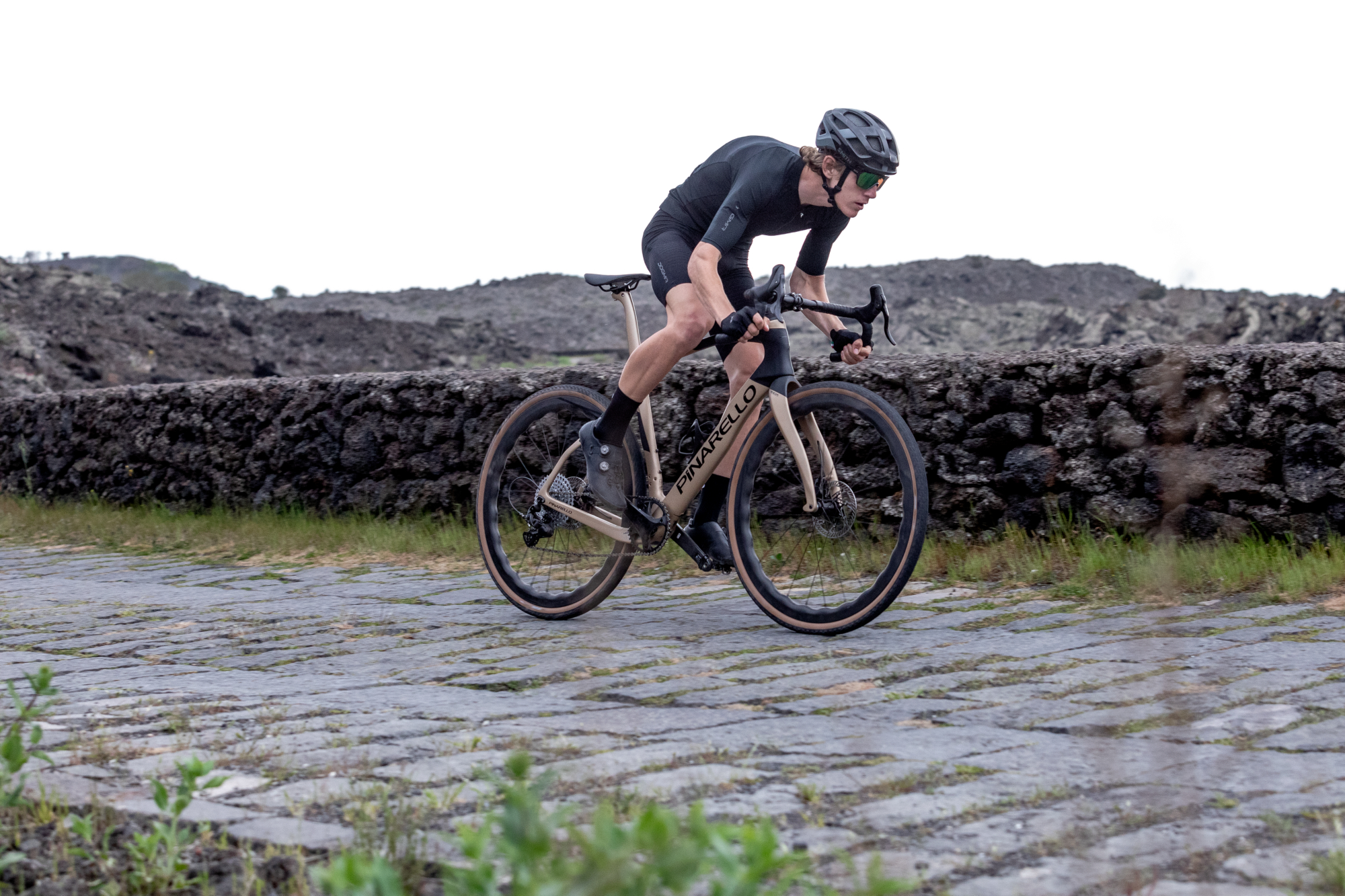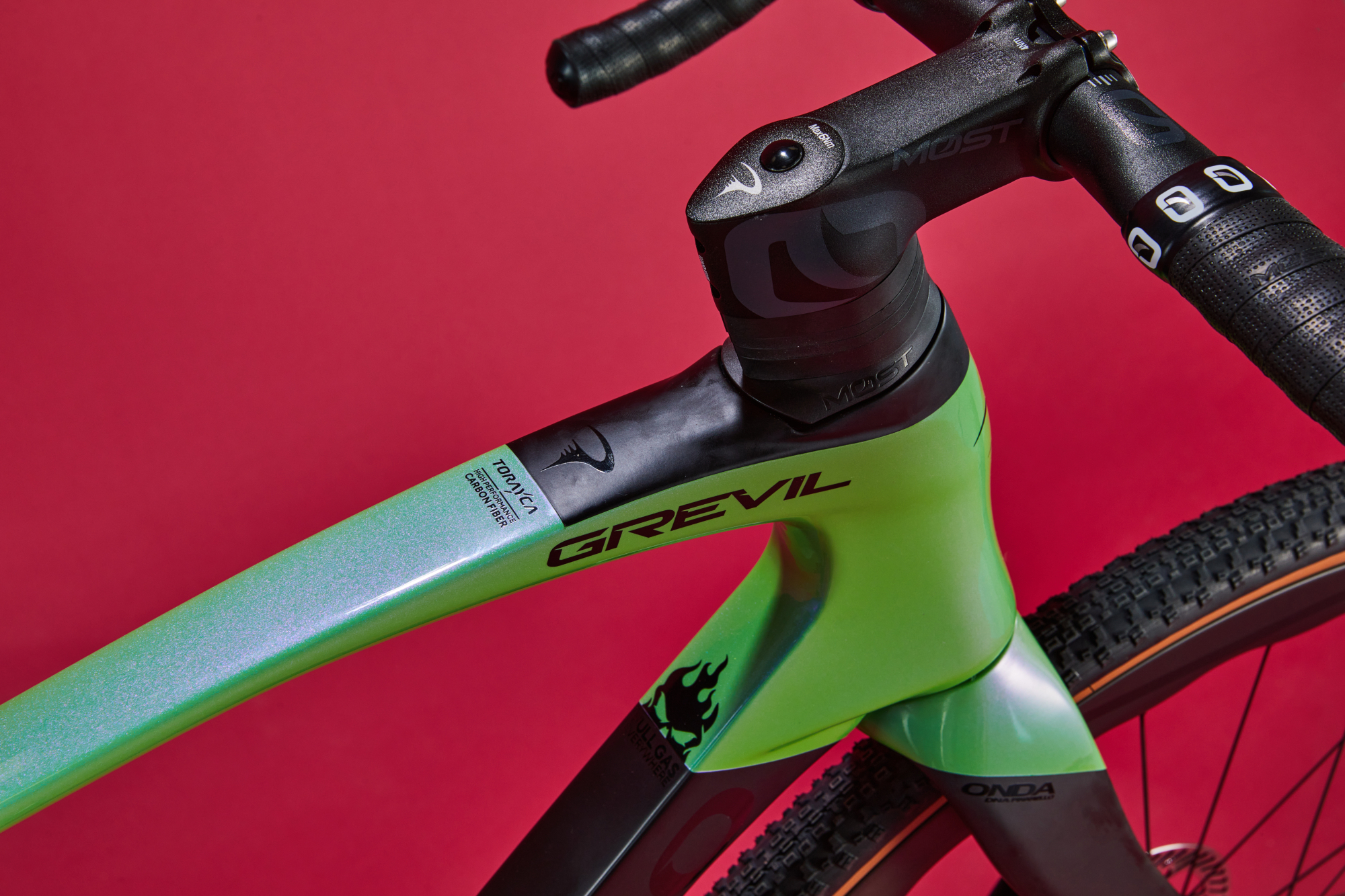Pinarello's new Grevil gravel bike is 'devoted to pure performance'
To better meet the demands of gravel racing the Grevil F features greater tyre clearance and aero updates

Pinarello has launched the Grevil F, the latest version of its competition-ready gravel bike.
The Italian marque, which supplies race bikes for the Ineos Grenadiers, released the original Grevil in 2018. The new model retains the familiar asymmetric frame design and ‘wave’ shaped forks that are the hallmark of all Pinarellos, including the Grevil, but has added a few notable changes.
Pinarello acknowledges that gravel racing has evolved; races are now more “diverse and complex” and the Grevil F, which it says is “devoted to pure performance”, has been redesigned with this in mind. Whether 'pure performance' is what most gravel riders are seeking is something we're looking forward to addressing in our full review, at a later date.

So, where are these race ready upgrades coming from?
For starters, Pinarello has adopted the Total Internal Cable routing (TiCR) system used on its Dogma road bike. Pinarello believes that given the long distances of many of today’s gravel races any aerodynamic advantages are welcome, no matter how small. Combined with the new ‘flat back’ profile of the downtube, designed to reduce drag, it says that the Grevil F is 4% more aerodynamic and saves five watts at 40 km/h compared to the previous model. The use of TiCR also cleans up the Grevil F cockpit compared to the previous model.
Analysis
There are so many interesting points about the Grevil it’s difficult to know where to begin. But let’s not beat about the bush and jump straight in with the boldest: the aerodynamism.
There’s a bit of a split of opinion when it comes to aero and gravel bikes. On the one hand, you have those who argue that the lower speeds and more turbulent airflow means that there’s less to be gained from certain aero optimisions.

Sure, don’t sit up like a sail and use a saddle or famebag rather than wind-catching panniers – but don’t bother putting on some deep section wheels. Dov Tate, founder of the wheel brand Parcours, has explained to us before how wide, knobby tyres disrupt the airflow and reduce the benefits compared to what you get with a road setup.
But at the same time, there are arguments – put forward by the likes of 3T, who have been mainstays of the aero-gravel bike niche for years – that we should be paying a bit more attention to the airflow when riding off-road.
First is the duration of time that’s spent out on the course. Although the slower speeds of gravel mean that you don’t get quite the same boost in absolute terms, going 1 kph faster for 10 hours will save you more seconds than going 5 kph faster for 20 minutes.
Second is that looking at the average speed can mask the amount of time spent at much faster speeds, and therefore the potential gains from improving aerodynamic efficiency (as drag increases exponentially with speed).
For instance, a rider who has an average speed of 20kph but has been travelling at mostly ~5kph and ~50kph because of the hilly terrain will have more to gain from getting aero than a rider who has simply been chugging along at 20kph for the whole duration.
Now, that has just been to take a quick peek into the can of worms that’s gravel and aero. There’s the whole other question (which won’t be answered now) of whether or not the aero tweaks of the Grevil are large enough to convey a significant advantage out in the real world – or if the biggest gains are simply going to be psychological.
Want our take? Stay tuned for our full review.
Geometry
The duration of gravel races also appears to have influenced a change here as well.
The Grevil F combines a shorter reach with a higher stack, which should mean greater extension of the arms. Pinarello says this allows for more flex through the arms, which translates to better cushioning over rough ground as well as more relaxed shoulders. The result, it claims, is improved comfort over longer distances. This new, compact geometry also raises the centre of gravity, which Pinarello says will lead to improved handling on technical terrain.

Consistent handling is also one of the reasons for the Grevil’s size specific geometry. Across the six frame sizes the rake and headtube angle is adjusted to ensure that the trail is kept the same no matter the size. Trail is the distance between where the steering axis of the front wheel intersects the ground and where the front tyre touches the ground and it has a significant impact on a bike’s steering. On the Grevil F the fork angle has been moved backward, from 70.25° to 72.25° depending on the frame size, while the rake has been increased to between 50mm and 55mm, which Pinarello says will improve the bike’s stability “in rough terrain”.
The variety of gravel races has also led Pinarello to increase tyre clearance on the Grevil F. It now can take tyre sizes up to 700x50mm or 650b x 2.1”, with the higher volume tyres offering improved comfort as well as adaptability for differing terrain. To help achieve this Pinarello redesigned the chainstays. It sounds as if it were quite the challenge.
Wanting to keep the Q-factor similar to a road bike without having to lengthening the chainstay, which would impact the Grevil F’s handling, Pinarello moved the stays downwards “in order to free the critical intersection zone” where the chainrings, wheel and chainstays meet . By doing so it was able to use a cross tube section of 14mm for the chainstay, which it says ensures “optimal rigidity”.
However, Pinarello also champions the Grevil F’s performance with far narrower tyres. Throw on some road wheels and 28mm rubber and it says it “flies like a road bike.” In fact, Pinarello goes as far as to say the Grevil F will perform over “any terrain with any wheel.”

While this claim would certainly require testing, the bike clearly is built with versatility in mind. The frame is made from Toray T700 carbon and uses a mix of high modulus and high tensile strength fibres to balance “rigidity and vibration absorption". In terms of stiffness, Pinarello states that the Grevil F is 8% stiffer in the bottom bracket area than the original Grevil.
The front derailleur hanger is also removable, to ensure a clean aesthetic if you opt for a 1x set-up over a 2x, while a bottle cage mount has been added to the underside of the downtube, which should appeal to bikepackers and endurance racers alike.
Other new design elements include a dedicated seat clamp, which borrows for the brand’s Prince range of bikes by placing the clamp at the front of the seat post, embedding it into the top tube to keep it away from dirt. The aero seat post is also designed to flex to further aid comfort.

Claimed frame weight for the Grevil F in a size 53cm is 1090g, while the ONDA fork has a climbed weight of 500g. A complete bike with Campagnolo's 13-speed Ekar groupset and Fulcrum Rapid Red 500 wheels comes in at £5,300 / $6,500.
The same build, but with a wheel swap for a set of Princeton Grit 4540 hoops, brings the claimed weight down to 8.55kg and the price tag up to £7,000 (US pricing is still to be confirmed).
For more detail visit pinarello.com. Otherwise, hang tight for our upcoming full review.

Thank you for reading 20 articles this month* Join now for unlimited access
Enjoy your first month for just £1 / $1 / €1
*Read 5 free articles per month without a subscription

Join now for unlimited access
Try first month for just £1 / $1 / €1
Get The Leadout Newsletter
The latest race content, interviews, features, reviews and expert buying guides, direct to your inbox!
Luke Friend has worked as a writer, editor and copywriter for twenty five years. Across books, magazines and websites, he's covered a broad range of topics for a range of clients including Major League Baseball, the National Trust and the NHS. He has an MA in Professional Writing from Falmouth University and is a qualified bicycle mechanic. He has been a cycling enthusiast from an early age, partly due to watching the Tour de France on TV. He's a keen follower of bike racing to this day as well as a regular road and gravel rider.
-
 'I'll take a top 10, that's alright in the end' - Fred Wright finishes best of British at Paris-Roubaix
'I'll take a top 10, that's alright in the end' - Fred Wright finishes best of British at Paris-RoubaixBahrain-Victorious rider came back from a mechanical on the Arenberg to place ninth
By Adam Becket Published
-
 'This is the furthest ride I've actually ever done' - Matthew Brennan lights up Paris-Roubaix at 19 years old
'This is the furthest ride I've actually ever done' - Matthew Brennan lights up Paris-Roubaix at 19 years oldThe day's youngest rider reflects on 'killer' Monument debut
By Tom Davidson Published